🎹 Yamaha NU1X Hybrid Digital Piano | UPDATED REVIEW | Dec 1, 2023 | Hybrid upright piano | $7399 internet price for polished ebony finish | The Yamaha piano company has been producing acoustic and digital pianos for many decades and is one of the premier piano companies in the world. Many superstar musicians, piano teachers, and universities own and play Yamaha pianos and in fact I own a couple of their pianos and use them in my large teaching studio. Yamaha is certainly not the only good digital piano company out there but there is no disputing they are in the top 3 companies making acoustic and digital pianos in the market today.
It comes as no surprise that of the 5 top digital piano companies in the world including Roland, Casio, Korg, and Kawai, Yamaha is the only company, other than Kawai (with their new NV5S at approx $9500 street price) that produces a full hybrid upright piano model and the Yamaha version is called the AvantGrand NU1X ($7399 discount internet price for polished ebony and $7599 for the polished white finish). The NU1X comes closer to replicating the actual piano key action playing experience of a real upright piano than any other model in the Yamaha line-up today.
REVIEW of now discontinued NU1X – So what is a hybrid digital piano and why are so many digital piano manufacturers calling some of their higher priced digital pianos…Hybrids? Well, that fact is that for years every digital manufacturer has been trying to figure out how to produce a digital piano that gets as close as possible to actually playing and sounding like a real organic high quality acoustic piano because that has always been the goal. But the technology available over the years to accomplish this task has been limited and the manufacturers could only do so much with what they had.
Unlike any other digital piano in this price range besides the Kawai Novus models), the Yamaha NU1X actually takes a real acoustic key action (built by Yamaha in their acoustic piano division) including all 88 individual wood keys and all moving parts for each key that would normally be in an acoustic upright piano, and they put that into the NU1X. In this price range there are a few manufacturers that offer a 100% wooden key or a partial wooden key, but beyond the wood key itself there are no other real authentic acoustic piano moving parts in the other brands. This is probably because it takes approximately 59 separate key action parts per
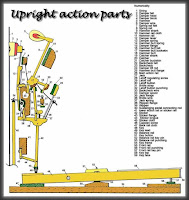
key including all the small original parts that go from the key up to the individual string in a real piano. So if you took all 59 parts in the key and hammer action (per key) and multiplied that number by 88 keys (total keys on a piano), you would have 5,192 total key action parts in an upright piano of which most of those parts are connected together and move in a specific way when you depress the key.
The NU1X key action has all these hundreds and thousands of parts that work together in harmony with each minus the actual felt hammers, wood soundboard, strings, and string parts (because there are no strings inside the NU1X) since the piano sound is produced electronically and then comes out a special internal speaker system specifically designed for this piano. So there are no strings, no soundboard to amplify the strings (don’t really need one), and because there are no strings the NU1X never needs tuning. So the question is…why is it necessary for Yamaha to build a digital piano with all of these 59 parts per key (minus the actual felt hammers, etc) when most digital pianos don’t have all these connected. complex parts? There are a number of digital pianos that do have wooden keys which move pretty well but the other parts of the key action are not there like they are in the NU1X. So does that really matter?
If the the key action moves properly in a digital piano then all you need next is a great piano sound chip with authentic piano sounds coming through a high quality internal audio system where the piano sounds behave “organically” along with responsive pedaling to control those piano sounds for sustain and/or soft playing. Ultimately this is what the Yamaha NU1X is all about…an acoustic piano playing experience without the strings and maintenance! No tuning, ever, the ability to control volume with a single master volume knob if you want to play more quietly which you cannot do on a real acoustic piano, using stereo headphones to play silently so as to not disturb others in the room or in the house which you cannot do on a real acoustic pianos, and finally having the ability to interface with external devices for music education, on-line piano lessons, and/or song writing, etc using computers, iPads, etc.
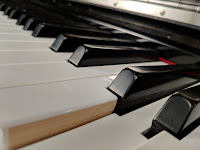 When it comes to describing the feel and movement of the NU1X, I would classify it as a lighter, fast moving, responsive key action that offers a great deal of expression. In fact the NU1X key action is quicker, lighter, and even more responsive that the Yamaha Clavinova CLP digital pianos…but it should be that way because it is designed to replicate the “real thing” and is also in a higher price range than most of the Clavinova CLP series of digital pianos with the exception of the new CLP-785 also being in a higher price range.
When it comes to describing the feel and movement of the NU1X, I would classify it as a lighter, fast moving, responsive key action that offers a great deal of expression. In fact the NU1X key action is quicker, lighter, and even more responsive that the Yamaha Clavinova CLP digital pianos…but it should be that way because it is designed to replicate the “real thing” and is also in a higher price range than most of the Clavinova CLP series of digital pianos with the exception of the new CLP-785 also being in a higher price range.
OK, so there is a very impressive key action in this model, but how does it translate to triggering and playing the piano sound in a way that reacts like a real piano for loud and soft, mellow to bright, playing the key lightly to get a delicate piano tone or playing the keys aggressively to get that thunderous piano sound, all of which is necessary for tonal dynamics and expression? The way Yamaha handles this is by using non contact “optical fiber” as opposed to the standard physical rubber key contacts under the piano keys as all the other models and brands of digital pianos have. This allows for a more precise piano sound response without needing to be limited to just 3 key contacts under each key.
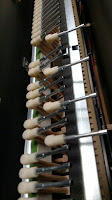
key/hammer movement without limitations. At the top of the NU1X action there are metal tubes (see pics at left side) that simulate the movement and weight of real actual piano hammers in a key action.
A few other things worth mentioning with regard to the NU1X key action is the fact the keys are properly weighted and graded in weight from bass through treble. There are actual physical weights in each key so that the bass keys have more weight as opposed to the middle octaves and upper treble octaves which have less weight, just like real acoustic upright and grand pianos. Also, unlike plastic key actions in digital pianos, each key in the NU1X is cut, installed, and operates independently of the keys next to it so that every key has an independent see-saw movement and is also more stable because each key is placed over an individual center metal pin so that the motion of that key can be isolated from any key around it plus that type of construction and key installation allows each key to function in tight formation one after the next without the lateral key movement that can occur in some non-wood digital piano key actions.


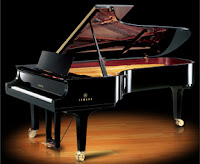
 As for the piano sound chip and the dynamic tonal realism that people are looking for, in my opinion the NU1X does not disappoint. In the prior model NU1, I was not very happy with the piano sounds because I felt they were just too artificial relative to what I had expected and what a good acoustic piano actually sounds like. However, in this new improved model NU1X, Yamaha completely redesigned their piano sound technology by using upgraded sound samples coming from the top Yamaha acoustic concert grand and the top European Bosendorfer (from Vienna Austria) concert grand combined with a new physical modeling process which Yamaha calls VRM or Virtual Resonance Modeling.
As for the piano sound chip and the dynamic tonal realism that people are looking for, in my opinion the NU1X does not disappoint. In the prior model NU1, I was not very happy with the piano sounds because I felt they were just too artificial relative to what I had expected and what a good acoustic piano actually sounds like. However, in this new improved model NU1X, Yamaha completely redesigned their piano sound technology by using upgraded sound samples coming from the top Yamaha acoustic concert grand and the top European Bosendorfer (from Vienna Austria) concert grand combined with a new physical modeling process which Yamaha calls VRM or Virtual Resonance Modeling.
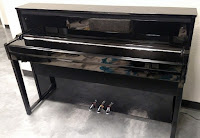




One more important area of the piano with regard to piano sound are the three pedals which include damper-sustain, sostenuto, and soft. Without good responsive pedals that also physically operate properly, your piano music especially for those who play at an intermediate through advanced levels, will be noticeably less realistic, have shorter sustain-decay times, and your music will sound more artificial. The most important aspect of the pedals is the damper-sustain (the right pedal) which should enable the piano sound to sustain (hold out the piano sound) at proper volume and sustain time levels so your music won’t be choppy and therefore will have a more beautiful tone.
There are piano shoppers out there who tell me they don’t need much more functionality and features in a digital piano other than they really just want the piano to just be a great piano and technologically maybe offer a few more things such as some additional piano and instrument sounds, a bit of recording capability, an electronic metronome, and some device connectivity to interface with a computer, iPad, etc. Basically that is what the NU1X is all about…a minimalistic approach to technology but in a way that still offers enough useful features for most people but not much more. The control panel is to the left side of the keyboard and has 9 very small hard buttons on it to control the user interface. The control panel uses a small LED display screen which displays numerical numbers and very basic letters to signify what functions or features you have selected.
With regard to pressing buttons or having display screens on the piano, I know that some people will say…”I really don’t care about the user operational experience of the piano because I just want to play the piano and not much more. But in this higher price range and given where we are with improved technology these days, in my opinion there really is no excuse (in my opinion) why Yamaha could not have devoted more attention to the user control panel and maybe just put in the same, more advanced control panel they already have in their new Clavinova CLP series of digital 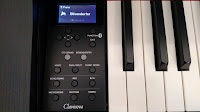 pianos, which is very nice and easy to navigate (even if Yamaha had to modify it just a bit).
pianos, which is very nice and easy to navigate (even if Yamaha had to modify it just a bit).
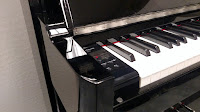 Yes, I know…Yamaha probably wanted to make this piano look as “minimalistic” as
Yes, I know…Yamaha probably wanted to make this piano look as “minimalistic” as
possible like they did in their previous NU1 model.
But they could have also accomplished this task in a different and more updated way that would have been a lot more satisfying. The piano already costs big dollars so how much more could it have been to update the display screen, buttons, and user interface?…definitely not much more and it would have been worth it because once a person buys this piano it’s not likely they are going to buy another piano for a very long time…if ever again. When I see so many good improvements in this new model when it comes to the actual piano playing experience and then Yamaha has to stick in its old, unintuitive technology when it comes to the control panel user interface, I just don’t understand why they would not want to update it but still keep it minimalistic in appearance?But on the brighter side of technology, since I first published this review Yamaha just came out with a new way to interface with the features and functions of the NU1X using their new Smart Pianist iOS app for iPad and iPhone which allow you to download this new app and control the NU1X from there. Now all the issues I have with the user interface of this piano have pretty much been solved when using this app to control the NU1X. If you have an iPad or iPhone (or will be getting one) then all you need to do is download the Smart Pianist app for free from the app store and then connect the device to your piano and start using the app to change instrument sounds, use
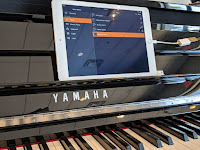
the recorder, add reverb effects, transpose to a different key, and play songs, etc and the operation to do this is simple, intuitive, and works great and the visual icons and controls that Yamaha has put into this app are fun to use as well.
OK…so now on to some other features of this piano which includes having adjustable touch sensitivity, reverb/echo effects to add more of a large room or hall effect on the piano sound, a 1-track 10 song MIDI recorder although I wish it would have been a least a 2-track MIDI recorder for separate left & right hand recording, a useful 1-track wav file audio recorder (which was not on the previous model) so that you can take a recording of yourself and transfer it through a USB flash drive inserted into the piano to then play on your computer or convert it to an MP3 file to play on your iPhone, iPad, etc.
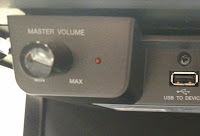 There is also an adjustable digital metronome for help with rhythm and timing along with tempo control, the ability to transpose electronically to any key, intelligent
There is also an adjustable digital metronome for help with rhythm and timing along with tempo control, the ability to transpose electronically to any key, intelligent
acoustic control, a stereophonic optimizer, and having a total of 15 very pleasing instrument sounds 5 of which are acoustic piano tones, 3 electric piano tones, 2 different classical harpsichord tones,
1 celeste, 2 pipe organs, 1 pop/jazz organ, and a piano-strings layered combination sound which is very nice. The prior model NU1 only had 5 total instrument sounds so the NU1X is definitely an improvement over the prior model in terms of the total sounds as well as the quality and authenticity of those instrument sounds. Unfortunately none of the 14 single tones can be layered or split with each other which should have been an easy thing to do in my opinion. Even the most basic inexpensive digital pianos can do that as can all the other non-AvantGrand series of Yamaha digital pianos. Yamaha obviously thinks the average user won’t care about that aspect of tone control on this model, but I beg to differ.On the NU1X as in the previous model, you can use stereo headphones to practice in privacy. But in the new NU1X as well as the new Clavinova 700 series,Yamaha has developed a new headphone technology called binaural sampling which simulates an audio multi-dimensional effect in which the result is like hearing the piano sound all around your head (as if you were not wearing headphones) rather than directly into your ears like normal headphone sound. This special effect is the result of Yamaha using a variety of specialty microphones to record the actual piano sound experience coming out of their top CFX acoustic grand piano and then processing that sound in a way to where you hear it through stereo headphones (any brand of headphones) like it would sound in an acoustic environment.
As far as connectivity goes, the NU1X has USB output to external device (computer, iPad, etc), USB flash drive memory stick input, 2 stereo headphone jacks, MIDI in & out connectors, stereo mini audio input jack, and dual auxiliary audio output jacks. A new feature on this model is audio Bluetooth connectivity. There are a few different digital pianos offering this feature these days including all off the Yamaha CLP Clavonva pianos with the exception of the first two models.

Bluetooth audio connectivity enables you to run your iTunes/ Google tunes through the very impressive piano speaker system wirelessly without need for cables so that you can hear your prerecorded audio song files coming through the piano speaker system from whatever Bluetooth song player device you may have.
This is a very useful feature because then you don’t have cables connected to or on the piano to get in the way of the cabinet and make things look messy, and the internal speaker system in the NU1X really makes the songs sound great. You can play along with them live on the NU1X hearing them through the speakers or through the headphones too. With Bluetooth connectivity one of the big benefits to that technology is that you can control your music from other parts of the home or room so that you do not need to be nearby to select, play, and hear your audio songs through the piano. So when it comes to connectivity this piano has what most piano shoppers want…lots of flexibility.
The quality of the internal speaker system in the NU1X is far superior to the previous NU1 in my opinion. In the past model I did not particularly like the sound coming through the speaker system because it sounded artificial to me and not at all like a real piano especially because sound was not coming out near the middle to top of the piano where hammers are normally striking the strings. In the NU1X Yamaha really improved that part of the playing experience with a more robust speaker system offering better components, more audio power with 4 speakers going into 180 watts of power.
 Speaking of sound, in an acoustic piano there are sound vibrations which come through the body of a piano coming up through the wooden keys when the hammers strike the strings and all those piano sound vibrations can be “felt” by your fingers as you touch the keytops. In other words, the keys themselves in an acoustic piano actually vibrate just a bit because of the strings causing vibrations throughout the body of the piano which can be felt by your fingers as they sit on top of the keys. All those organic wood parts that connect each key to the hammer in a regular piano are resonating when the strings are vibrating and being heard which gives the player a much more organic connection to the piano. So not only can you hear the piano but you can feel what you are playing through the keys.
Speaking of sound, in an acoustic piano there are sound vibrations which come through the body of a piano coming up through the wooden keys when the hammers strike the strings and all those piano sound vibrations can be “felt” by your fingers as you touch the keytops. In other words, the keys themselves in an acoustic piano actually vibrate just a bit because of the strings causing vibrations throughout the body of the piano which can be felt by your fingers as they sit on top of the keys. All those organic wood parts that connect each key to the hammer in a regular piano are resonating when the strings are vibrating and being heard which gives the player a much more organic connection to the piano. So not only can you hear the piano but you can feel what you are playing through the keys.
I really do like the design and look of the NU1X cabinet at approx 40″ tall x 60″ wide x 18″ deep and this new model looks just like a real acoustic piano although the weight of this model being only 240lbs is definitely lighter than an actual acoustic piano of the same height which weighs approximately 350lbs. I think the design of the NU1X is quite elegant with its front support legs and contemporary lines combined with a few nice curves along the outside of it and a music holder rack that can be flipped down to support the sheet music once the key cover is opened up. In my opinion the NU1X is an outstanding mix of just enough features to keep most people
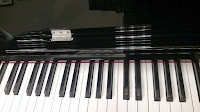
very happy who like technology along with a cabinet design and finish including a slow-close fallboard key cover and matching padded bench which offers an expensive look to all of it while keeping the measurements and weight in just the right place that work for most rooms. The back of the piano is closed once it is assembled so that you cannot see through the piano from the front of it and therefore does not give off the appearance of a typical digital piano.
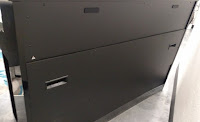
piano which goes dark in a few seconds after you select a function button, the piano takes on an acoustic look to it and can fool someone into believing that the NU1X is really just a nice looking, great feeling, beautiful sounding acoustic piano which is always in tune. But for its $7400 price tag, it better be nice and do something special because you can buy some pretty nice new acoustic pianos and other digital pianos for that money! So why would someone want this piano when there are so many other options? That’s a

pretty easy question to answer because the NU1X is the only digital piano on the market in its price range which has an authentic “complete” (except for the felt hammers & strings) acoustic piano key action inside of it along with being able to produce a very impressive grand piano sound with traditional full pedaling with no tuning ever and the ability to be played quietly or silently.
If you want more info on new digital pianos and LOWER PRICES than internet discounts, please email me at tim@azpianowholesale.com or call direct at 602-571-1864.







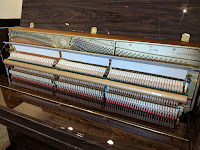
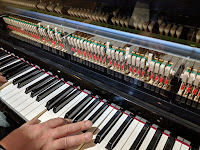
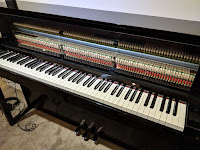

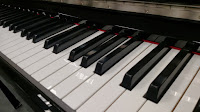
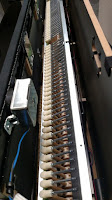
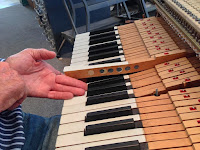
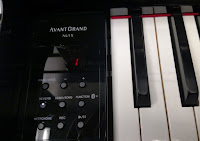
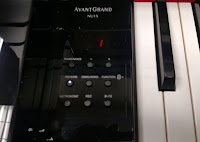
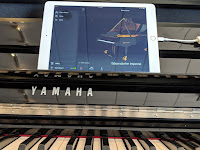

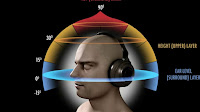

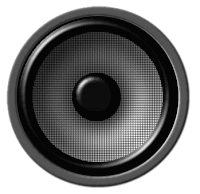
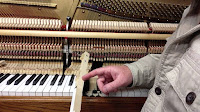
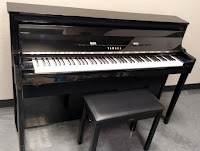










Thank for for this very thorough review. The effort is appreciated.
Tim, what a fantastic review… Thank you so much for everything you do. I wished I lived in the US so that I could thank you by buying my next digital piano from you.
I’ve only been playing for 1.5 years, but was very discouraged that even high-end digital pianos keyboards were, in my beginner’s opinion, far from feeling similar to my teacher’s U1. I discovered hybrids (NU1X) this week and… wow. This is much closer to the real deal, in terms of touch.
I am worried however about the loud notes defect.
3 questions, if you happen to have the time to answer:
1. About the loud notes defect: NU1/NU1X owners say that as their technique improved, the problem became rarer or never happened anymore. I suppose that it comes down to letting the key go back up sufficiently before hitting it again. But is this actually “improving the technique“ or is it bad practice, just a way to get around the defect? And do you feel like this makes sense, that you can improve your technique and get rid of the defect? Or you shouldn’t have to improve your technique for the piano to sound right?
2. If you do not think that improving technique will help with the issue: at what “level” will a student start noticing the issue while playing? I understand that “time” depends on each person, but is it an issue you might encounter in your first 2-3-4 years of practice? Or can one buy the NU1X for these first years and then upgrade when starting to play more advanced pieces, that triggers the defect?
3. You “recommended” the NU1, but only “semi-recommend” the NU1X, despite saying that it has improved everything that was not perfect in the NU1 (better speakers, better samples, VRM, binaural for headphones, slightly improved keyboard). Is it because you had not discovered the loud notes defect at the time of trying the NU1, and would only have “semi-recommended” it had you noticed the defect?
Thank you so much again,
Kevin
I also have same question.
As of now Yamaha has apparently resolved the intermittent "loud notes" issue in the NU pianos and they are performing normally at this point…which is a good thing.
I just bought this piano in HK, I can say this is sounding 85% like my previous U1 on speaker and 95% on headphone. And this is much more natural sounding than CLP-685
Thank you for this review! It is greatly appreciated. Just bought one of these — super excited!
I ws really close to buying this piano, but for one point: The glissando feels a lot stiffer (and hence painful) than the U1 and U3 that I tried at the store. Is the action of the NU1X supposed to be the same as the U1?
What is your personal experience with glissandos on your NU1X? Thanks!
I haven't seen the loud note issue explained in any threads to date. I spoke with a Yamaha rep the other day in store, and he said the loud note issue is resolved – the problem had arisen because most people were striking the keys as soon as the piano was switched on, instead of waiting until the piano was ready to play, and this was leading to the loud note issue. It explains why it was an intermittent problem I think. I found this reassuring.
the intermittent loud note issue was a big problem on the previous NU1. It was not due to the initial power up and then being played right away. I experienced those same issues on the NU1 and it was powered up and played correctly. It turned out to be a software issue that took a long time for Yamaha to resolve and the newer model NU1X did not have those issues after the operating system was finally fixed and updated.
I think it is much better to buy a Casio hybrid grand piano GP-510 or GP-310 that both have a grand piano keyboard action and touch than this NU1X AvantGrand upright piano!!! Just to have a grand piano keyboard action and touch with these two Casio hybrid grand pianos.
The first goal of the hybrid grand piano was to provide a grand piano keyboard action and touch but they decided to also introduce an upright version and, by doing so, they defeated the original goal of the hybrid grand piano.